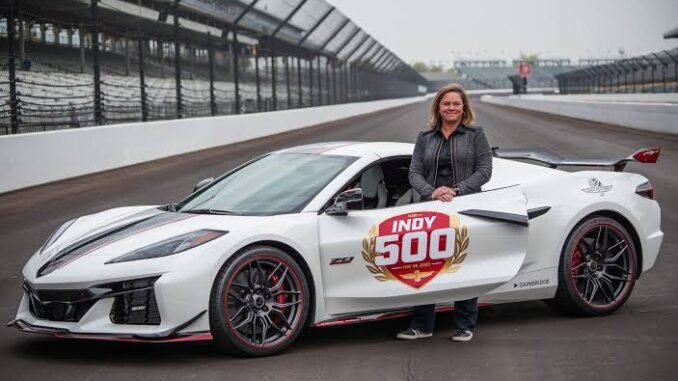
This is the starting lineup for the 2022 Indianapolis 500. The 200-lap race is scheduled for Sunday, May 29 at the 2½-mile Indianapolis. Today we will discuss about 2022 Indianapolis 500: Qualifying| Starting grid| Pace car
2022 Indianapolis 500: Qualifying| Starting grid| Pace car
The 2022 Indianapolis 500 (branded as the 106th running of the Indianapolis 500 presented by Gainbridge for sponsorship reasons) is a 500-mile (800 km, 200 lap) race in the 2022 IndyCar Series, scheduled for Sunday, May 29, 2022. . Indianapolis Motor Speedway in Speedway, Indiana. The month of May formally began on 14 May with the GMR Grand Prix on United Roadways. Practice on the oval opened on 17 May, and the time trial took place on 21–22 May. Carb Day, the traditional final day of practice, along with the pit stop challenge, is scheduled for May 27.
| Indianapolis Motor Speedway | |
|---|---|
| Indianapolis 500 | |
| Sanctioning body | INDYCAR |
| Season | 2022 IndyCar season |
| Date | May 29, 2022 |
| Pole position | |
| Pole speed | 234.046 mph (376.661 km/h) |
| Fastest qualifier | |
| Pre-race ceremonies | |
| National anthem | Jordan Fisher |
| “Back Home Again in Indiana” | Jim Cornelison |
| Starting command | Roger Penske |
| Pace car | Chevrolet Corvette (C8) |
| Pace car driver | Sarah Fisher |
Qualifying

This is the starting lineup for the 2022 Indianapolis 500. The 200-lap race is scheduled for Sunday, May 29 at the 2½-mile Indianapolis Motor Speedway oval.
The starting lineup of the Indy 500 consists of 11 lines of three drivers, established through two days of qualifying. The field average of 231.023 mph is the fastest in the history of the race.
Includes starting position, (car number), driver’s name (R-rookie; W-Indy 500 winner), team, engine and 4-lap qualifying speed average. All cars have Dallara chassis and use Firestone tyres. On 22 May the pace was set for rows 1–2 in Fast Six, and the pace for Rows 3–4 was set in Fast 12; The pace for rows 5–11 was set on 21 May.
Pole sitters Scott Dixon (from left), Alex Palu and Rinus VK, front row for the 2022 Indianapolis 500.
Indy 500 Row 1
1. (9) Scott Dixon (W), Honda, Chip Ganassi Racing, 234.046
2. (10) Alex Palu, Honda, Chip Ganassi Racing, 233.499
3. (21) Rinus VK, Chevrolet, Ed Carpenter Racing, 233.385
Ed Carpenter (from left), Marcus Ericsson and Tony Kanan, row 2 at the 2022 Indianapolis 500.
Indy 500 Row 2
4. (33) Ed Carpenter, Chevrolet, Ed Carpenter Racing, 233.080
5. (8) Marcus Ericsson, Honda, Chip Ganassi Racing, 232.764
6. (1) Tony Kanan (W), Honda, Chip Ganassi Racing, 232.372
Pato O’Ward (from left), Felix Rosenquist and Romain Grosjean, row 3 for the 2022 Indianapolis 500.
Starting grid

Scott Dixon saved his best for last and stoked the youth movement at Indianapolis Motor Speedway on Sunday, running a four-lap average of 234.046 mph to win pole for the 106th Indianapolis 500 on May 29. It is the fifth Indy 500 pole for the 41-year-old Dixon, who started from the top spot on the grid in 2021, 2017, 2015 and 2008 – when he won the race.
Sharing the front line with the New Zealander will be his Chip Ganassi Racing teammates, defending Series champion Alex Palu, 25, and Rinus VK, 21, of Ed Carpenter Racing.
After going out first in the Fast 12 segment, Dixon proved to be the fastest as the field down was pushed to the top six by the fastest who would go for pole, and he was able to make the necessary subtle adjustments to stay ahead of the changing track conditions. was capable. Be fastest in the last group, where he was the last driver to attempt.
Consistency is key at the brickyard, where an average of four laps is taken, and the veteran displayed the calm, quick hand and calm demeanor he is known for setting the fastest four-lap average in Indy 500 qualifying history, 1996 To break Scott Breton’s mark of 233.718.
Pace car
It was Karl Fischer, the founder of the Indianapolis Motor Speedway, who came up with the idea of eliminating permanent starts for the more spectacular – and in Fischer’s mind, safer – rolling start. He would lead the field – at that time, 40 cars were arranged in eight rows of five! – Stoddard-Dayton driving at 45mph.
Each Indy 500 has used a speed car since then. Fischer pioneered the first five and then it became a duty and honor of various automotive industry figures or retired racers, and a great marketing tool for car manufacturers to supply cars. For example, a 1926 Louis Chevrolet piloting a Chrysler had the potential to raise some interesting engagements – and also caused some issues after the race. From 1936 it became customary for a 500 winner to be awarded a pace car, but in ’65, the Ford Motor Company, which was fundamental to Team Lotus’ attack on the Indy 500, handed over the keys to the Plymouth Sport to its winner Jimmy Clark. not allowed to accept. fury speed car.
